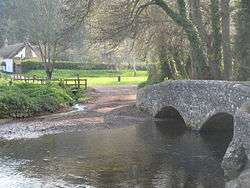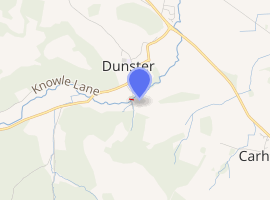Gallox Bridge, Dunster
The Gallox Bridge in Dunster, Somerset, England dates from the 15th century. It has been designated as a Grade I listed building and scheduled monument.[1][2] The bridge is in the guardianship of English Heritage.
Gallox Bridge | |
|---|---|
 | |
| Coordinates | 51.1790°N 3.4458°W |
| Carries | Pedestrians |
| Crosses | River Avill |
| Locale | Dunster, Somerset, England |
| Heritage status | Grade I listed building and scheduled monument |
| Characteristics | |
| Material | stone |
| Total length | 13.5 metres (44.3 ft) |
| Width | 1.9 metres (6.2 ft) |
| No. of spans | 2 |
| History | |
| Construction end | 15th century |

| |
The stone packhorse bridge crosses the River Avill at the southern end of the village, below Dunster Castle at a point which may have been the limit of tidal flow during the medieval period. It was important for the transport of wool and other goods to the market within the village which was established by 1222. The name is derived from the nearby gallows. The narrow bridge is approach via a raised causeway for pedestrians, while wheeled traffic uses the adjacent ford.
History
The bridge crosses the River Avill which rises on the eastern slopes of Dunkery Beacon and flows north through Timberscombe and Dunster flowing into the Bristol Channel at Dunster Beach. It is likely that there was a previous bridge on the same site as in the 14th century it was known as Doddebrigge.[3] The bridge may have been at the limit of the tidal mouth of the river during the medieval period.[4] Dunster Beach, which includes the mouth of the River Avill, is now located approximately 0.5 miles (0.80 km) from the village, and used to have a significant harbour, known as Dunster Haven, which was used for the export of wool from Saxon times; however, it was last used in the 17th century and has now disappeared among the dykes, meadows and marshes near the shore.[5]
Dunster had become a centre for woollen and clothing production by the 13th century, with the market dating back to at least 1222, and a particular kind of kersey or broadcloth became known as 'Dunsters'.[4][6] The prosperity of Dunster was based on the wool trade, with profits helping to pay for the construction of the tower of the Priory Church of St George and provide other amenities.
The name Gallox is believed to be derived from gallows as the village gallows were nearby,[7] when it was called Gallocksbrigge.[8] The bridge is close to Dunster Working Watermill and the base of the hill on which Dunster Castle sits and provides access to the site of the Deer park. It also falls within the Dunster Conservation Area.[9] It has been in the guardianship of English Heritage since the 1950s.[10]
Architecture
It is a narrow stone packhorse bridge, on the southern outskirts of Dunster, with two arches over the River Avill. It has a roadway width of 1.2 metres (3.9 ft), a total width of 1.9 metres (6.2 ft) and is 13.5 metres (44.3 ft) long.[11][12] The side of the bridge each have four narrow chamfered ribs.[2] The approach from the village is via a raised causeway.[13]
References
- Historic England. "Gallox Bridge (Grade I) (1296207)". National Heritage List for England. Retrieved 13 April 2009.
- Historic England. "Gallox Bridge: Scheduled Monument (1014410)". National Heritage List for England. Retrieved 21 January 2015.
- "History of Gallox Bridge". English Heritage. Retrieved 27 April 2015.
- Gathercole, Clare. "Dunster" (PDF). The Somerset Urban Archaeological Survey. Somerset County Council. Archived from the original (PDF) on 25 December 2013. Retrieved 6 June 2014.
- Farr, Grahame (1954). Somerset Harbours. London: Christopher Johnson. pp. 138–140.
- "Yarn Market Dunster". Everything Exmoor. Retrieved 21 January 2015.
- "Gallox Bridge". Crown Estate. Archived from the original on 14 July 2014. Retrieved 21 January 2015.
- Carter, Katy (2004). Heritage Unlocked: Guide to free sites in Devon, Dorset and Somerset. English Heritage. pp. 64–65. ISBN 978-1850748755.
- "MSO9409 - Gallox Packhorse Bridge, Dunster". Exmoor National Park Historic Environment Record. Exmoor National Park. Retrieved 21 January 2015.
- Chapple, Nick. "A History of the National Heritage Collection. Volume Eight: 1970-1983" (PDF). English Heritage. p. 30. Archived from the original (PDF) on 18 May 2015. Retrieved 28 April 2015.
- Historic England. "Gallox Bridge (36854)". PastScape. Retrieved 10 October 2017.
- Hinchliffe, Ernest (1994). Guide to the Packhorse Bridges of England. Cicerone. pp. 148–149. ISBN 978-1852841430.
- "Gallox Bridge, Dunster". Everything Exmoor. Retrieved 21 January 2015.
External links
| Wikimedia Commons has media related to Gallox Bridge. |